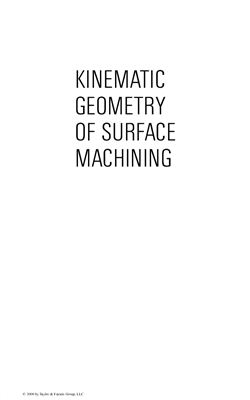Монография. CRC Press, 2007. - 516 p.
The principle of Occam’s razor loosely translates to the simplest solution is often the best. The author of Kinematic Geometry of Surface Machining utilizes this reductionist philosophy to provide a solution to the highly inefficient process of machining sculptured parts on multi-axis NC machines. He has developed a method to quickly calculate the necessary parameters, greatly reduce trial and error, and achieve efficient machining processes by using less input information, and in tu saving a great deal of time. This unique method will allow youto calculate optimal values for all major parameters of sculptured surface machining on multi-axis NC machines.It is much faster than conventional methods because it requires only minimal input information for the development of extremely efficient machining operations. Radzevich simply utilizes the geometric information of a particular part surface to be machined for developing optimal surface machining process rather than wasting time dealing with unnecessary data. This one-of-a-kind resource guides you through this cutting-edge technique beginning with an analytical description of part surfaces, the basics of differential geometry for sculptured surfaces, and the principal elements of the multi-parametric motion on a rigid body in E3 space theory. The book reveals the analytical method for investigating cutting tool geometry and explains a set of described conditions required for proper part surface generation. Next, the author illustrates the selection of criterion for optimization and describes the synthesis of optimal machining operations. He includes examples of the DG/K based method of surface generation implementation. Written by a leading expert in the field who holds over 150 patents, Kinematic Geometry of Surface Machining invokes Occam’s well-known philosophical principle so that you can apply the simplest solution to achieve optimal, time-saving surface machining processes.
The principle of Occam’s razor loosely translates to the simplest solution is often the best. The author of Kinematic Geometry of Surface Machining utilizes this reductionist philosophy to provide a solution to the highly inefficient process of machining sculptured parts on multi-axis NC machines. He has developed a method to quickly calculate the necessary parameters, greatly reduce trial and error, and achieve efficient machining processes by using less input information, and in tu saving a great deal of time. This unique method will allow youto calculate optimal values for all major parameters of sculptured surface machining on multi-axis NC machines.It is much faster than conventional methods because it requires only minimal input information for the development of extremely efficient machining operations. Radzevich simply utilizes the geometric information of a particular part surface to be machined for developing optimal surface machining process rather than wasting time dealing with unnecessary data. This one-of-a-kind resource guides you through this cutting-edge technique beginning with an analytical description of part surfaces, the basics of differential geometry for sculptured surfaces, and the principal elements of the multi-parametric motion on a rigid body in E3 space theory. The book reveals the analytical method for investigating cutting tool geometry and explains a set of described conditions required for proper part surface generation. Next, the author illustrates the selection of criterion for optimization and describes the synthesis of optimal machining operations. He includes examples of the DG/K based method of surface generation implementation. Written by a leading expert in the field who holds over 150 patents, Kinematic Geometry of Surface Machining invokes Occam’s well-known philosophical principle so that you can apply the simplest solution to achieve optimal, time-saving surface machining processes.

